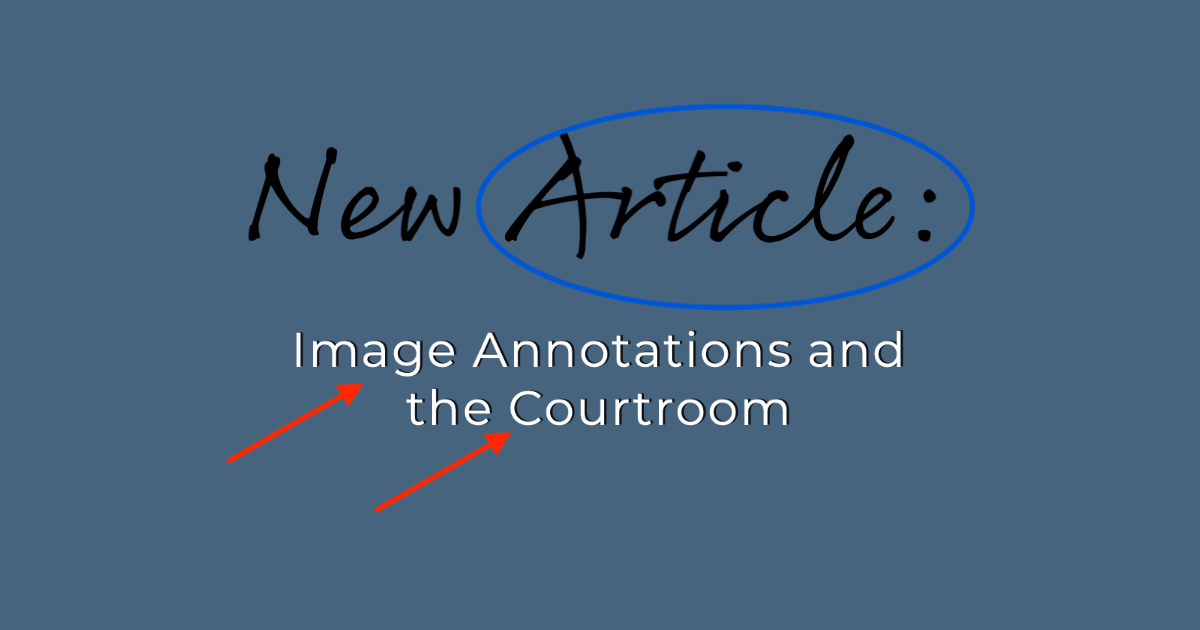When is it permissible to include annotations on images presented as evidence in court? Are there limits to the types of annotations that are permitted? How can you make a strong case for admission? This article discusses these questions and charts a strategy for obtaining favorable rulings on this topic.
While some images may be sufficiently clear that their meaning can be adequately conveyed to the viewer without interpretative assistance, that is not universally the case. It is often necessary and advisable for an expert witness (typically a forensic video analyst) to provide interpretive assistance to the trier of fact to ensure that the full and correct meaning of the images is communicated. The issue that arises is how that should be accomplished in such a way as to gain admissibility in the courtroom.
Annotations are graphics that are added to an image for the purpose of focusing the viewer’s attention on specific content features. They may take the form of lines, arrows, circles, ovals, boxes, or spotlighting. Annotations are not a substitute for testimony regarding the images. They are instead intended to supplement testimony so that as the witness talks about a certain content feature, the viewer is graphically drawn towards it. Annotations are effectively testimonial efficiencies. In an earlier article on this website entitled Always Have a Plan “B” for Your Courtroom Presentation, I noted that on occasion courts will restrict or eliminate the use of annotations. In my law lectures, I comment on other Canadian and US cases on this point and the variation of rulings given as to whether annotations are admissible.
Recent Case
A recent Canadian case is a useful precedent regarding the use of annotations. R. v. Truong, 2021 ABQB 856, is an Alberta Court of Queen’s Bench voir dire decision that is worthy of consideration. In this murder prosecution, one of the issues that was addressed pre-trial was whether it was acceptable for a police crime analyst (not an expert witness) to use circles and arrows to draw attention to specific aspects of surveillance video images, which formed a major component of the prosecution’s case.
Crime analysts prepared a sequential presentation of selected surveillance video images intended to convey information about certain individuals being in certain locations at certain times, all of which were relevant to the allegations before the court. Annotations in the form of red arrows and circles were used to point out or highlight aspects of selected images. Annotations were also added to comparison images and were designed to show similarities between items of clothing or luggage from one image to the next. The defence argued that the annotations should be excluded because they amounted to an impermissible form of opinion evidence about the highlighted items. However, the defence conceded that the Crown would be entitled to present identical annotations on the images during its closing argument to the jury so the issue to be decided in the voir dire was whether the analyst should also be able to present them while testifying about the surveillance images to the jury.
Relying upon a helpful decision from the Ontario Superior Court of Justice in 2017 (R. v. Gough, 2017 ONSC 1407), the Court found that the annotations would be helpful to the jury in understanding and following the analyst’s evidence. The Court noted that the proposed annotations were not overly prominent nor were they used on every slide in the presentation. Further, an instruction could be given to the jury to alert them as to the proper use of the annotations as a helpful tool, but not as an opinion. It is the function of the trier of fact to ultimately evaluate the surveillance images and determine their factual value. The annotations can be helpful in the search for the truth as it will draw the attention of the jurors to certain features of the images that might otherwise not be noted or appreciated. Jurors can tell the difference between the actual evidence (the images) and the supplemental annotations. In short, the annotations are not evidence of anything; the images are the evidence. With these comments, the Court ruled the annotations to be admissible.
Curiously, the Court made no mention of several Canadian decisions that have ruled image annotations to be partially or wholly inadmissible. Though it cannot be determined from this ruling, it may be that those cases were not presented to the Court. Otherwise, I would have expected the Court to have evaluated the contra cases as well.
The Takeaway
The value of the Truong and Gough decisions is that they carve out a way in which annotations can be shown to aid in the search for the truth. The ability to convince the court of their value is dependent upon the work of the analyst and the arguments of counsel. The analyst should ensure that the annotations are subtle and limited in scope. Previous cases excluding annotations have sometimes focused on the overwhelming or confusing way in which they have been used. Annotated slides should not look like a complex road map or stock market analysis, nor does every slide need to have annotations. Every annotation must be shown to have a valid purpose. Contrary to Truong, I advocate against using the colour red for annotations as red may be found to be prejudicial. A more neutral yet visible colour should be selected.
Counsel must be able to articulate how the annotations will assist the trier of fact in understanding the full breadth of the image content. Further, counsel should note that the annotations are not considered to be evidence, but rather serve as demonstrative aids to point out certain features in the evidential image. When counsel notes that they plan to highlight the same features in final argument, much of force of the defence exclusion argument should be diminished. In short, annotations serve a valid purpose in the search for the truth, but they must be applied with forethought, discretion, and accuracy.
